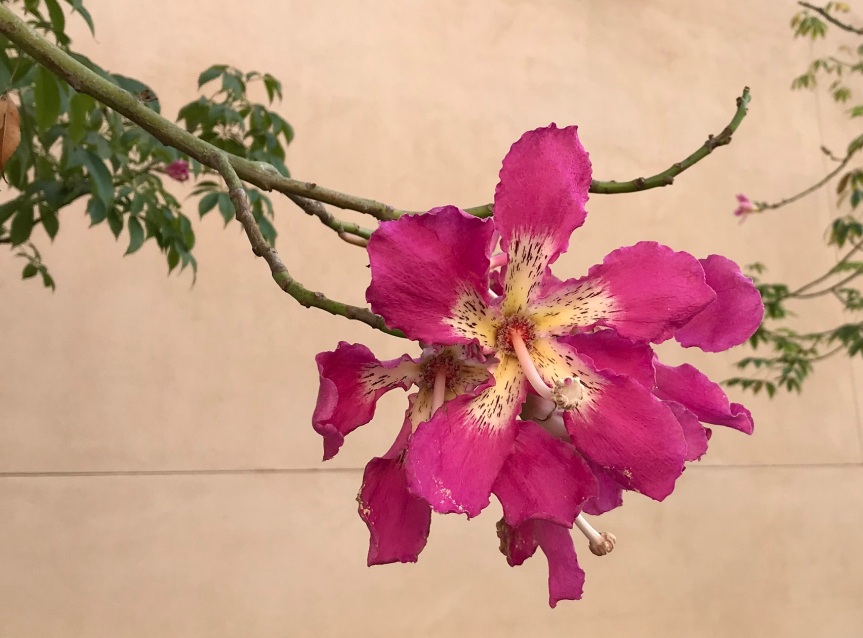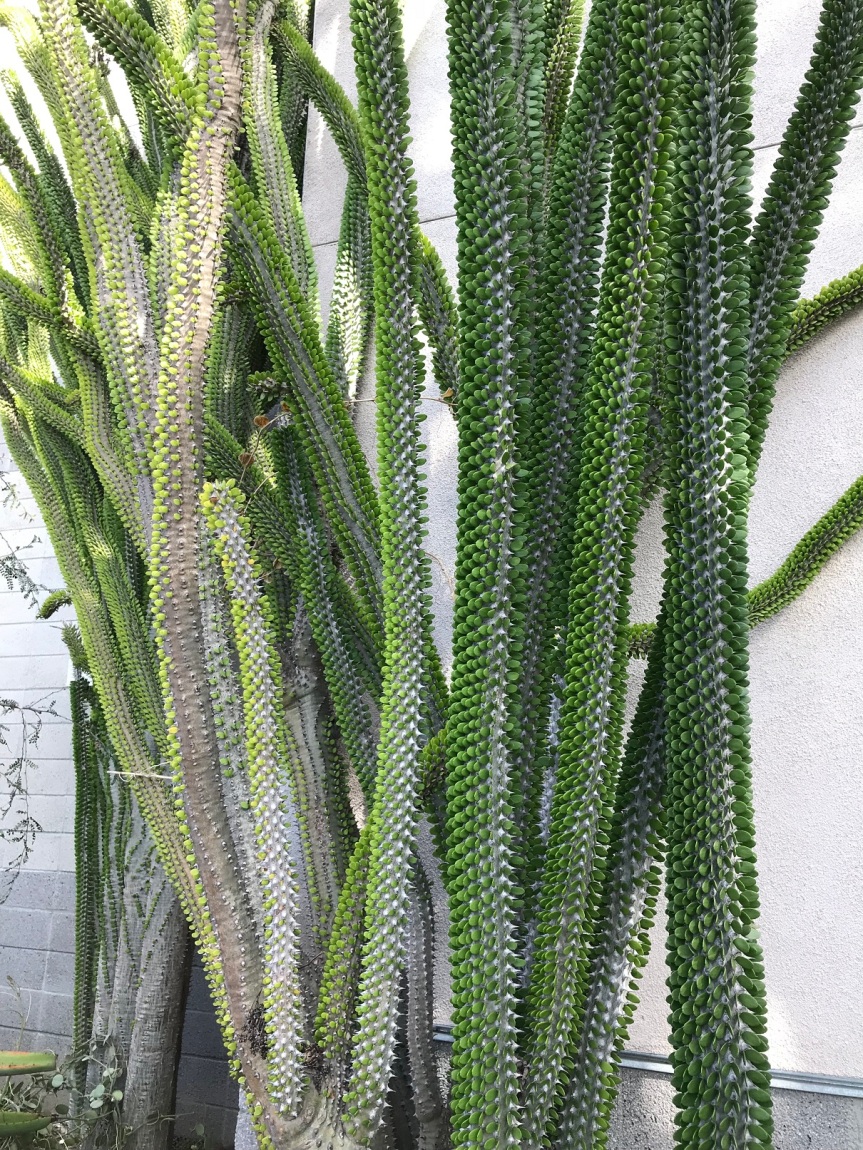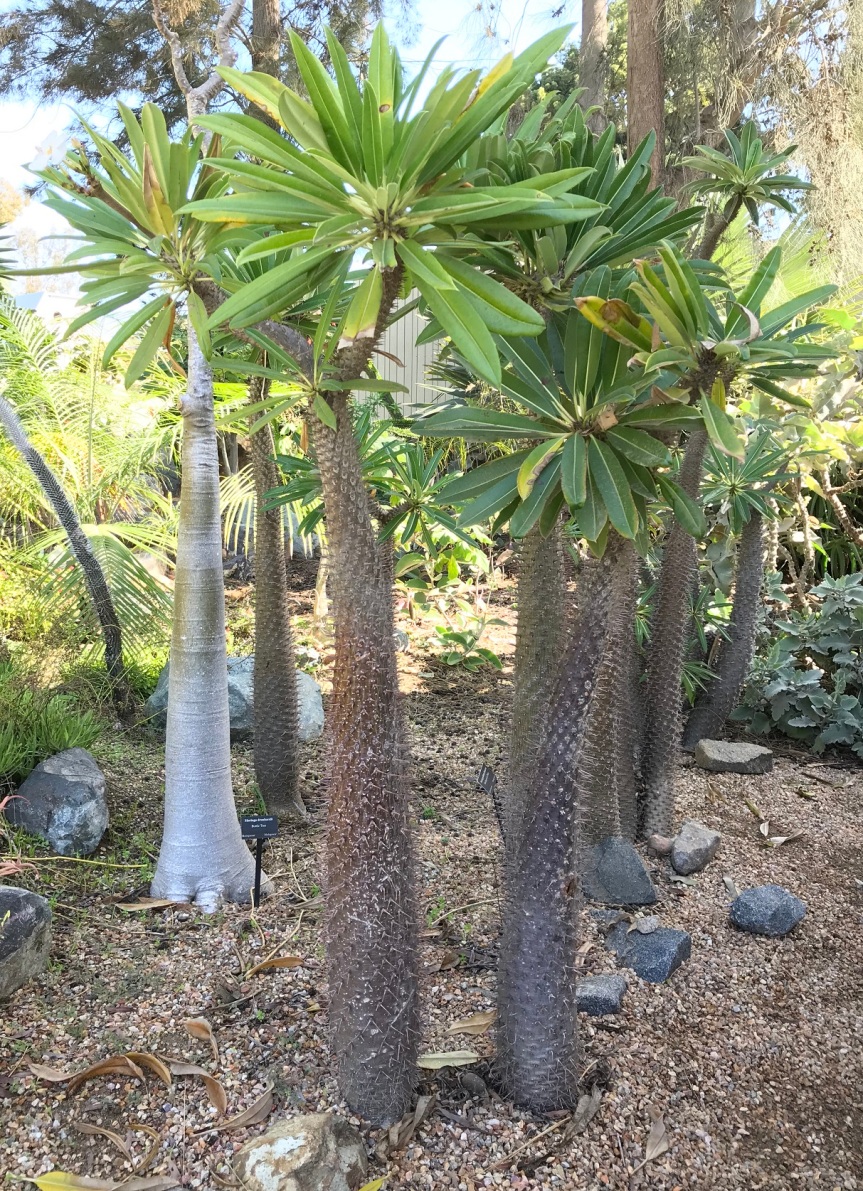
This week, I traveled to San Diego, California for a scientific conference. It was my first trip to San Diego–my first trip to anywhere in California, actually–so it was exciting to see a new part of the country. Even the flower beds around my hotel and the convention center were full of new and interesting things.
The meeting didn’t leave much time for sightseeing, but I managed to slip away one morning and take a bus up to Balboa Park, which houses the San Diego Zoo and a variety of gardens. I considered just wandering around the free areas of the park but eventually decided that I couldn’t miss the world famous zoo. That turned out to be the correct choice. In addition to being an amazing collection of endangered species (the zoo is famous for its captive breeding successes), the grounds are also a very fine botanical garden. The weather was cool, so the animals were active, and there were hardly any visitors. I had a good long visit with the pandas (red and giant), koalas, Tasmanian devils, komodo dragon, giant tortoises, okapis, elephants, jaguars, and many other animals, but I took more pictures of the plants.
Today being Saturday, here are six things that caught my eye in San Diego–garden related, of course.
1. Flowering trees.
November is clearly not the best time of year for blooming trees, but nevertheless, I saw some beautiful tropical and subtropical flowers.




2. Bird of Paradise flowers

Strelitzia reginae (bird of paradise) and Strelitzia nicolai (white bird of paradise) were growing (and blooming) all over town. S. reginae is my wife’s favorite flower, so when we were newly married I tried growing some from seed. After fifteen years, I managed to get a only single flower from an enormous clump that took up a lot of real estate in the greenhouse, so I gave up. Clearly, flowering is not a problem when they are grown outside in San Diego.

3. The Botanical Building

The Botanical Building is a Balboa Park landmark that was originally built for the 1915-1916 Panama-California Exposition. Before seeing it, I had assumed it was some sort of greenhouse or conservatory, but there is no glass involved. Instead, the Botanical Building is a giant lathe house, built of wooden strips that provide the perfect amount of shade and wind protection for palms, tree ferns, and other tropical/subtropical understory plants.



4. Australian plants
Callistemon ‘Woodlanders Hardy’ and one or two eucalyptus are the only Australian plants I know of that can be grown in North Carolina, and even those are marginal outside of the coastal plain. The climate of southern California is more similar to parts of Australia, so I wasn’t surprised to see a wider variety of plants from Down Under.



The zoo has a really impressive collection of succulents from Madagascar and southern Africa.





6. Hawaiian plants
I suppose the climate of Hawaii, particularly on the drier leeward side of the islands, must be not entirely unlike that of coastal San Diego County.


For more Six on Saturday, click over to The Propagator, where you will find his Six and links to other participants.

Your enthusiasm for tropical plants is inspiring. To be honest, I’v never had much interest (since I prefer to travel to cooler climates), but I’m likely to give them more attention now.
LikeLiked by 1 person
Fabulous photos of tropical plants. It started me wondering about how plants evolve in such strange, exotic and often beautiful ways depending on their climates.
LikeLiked by 1 person
Yes! Learning about the “endless forms most beautiful” is a large part of what makes horticulture fun for me.
LikeLike
WOW ! I would have loved to be in your place … All these plants and exotic trees are wonderful, Nick … California has the perfect weather for that … Did you buy and bring plants back home?
LikeLiked by 1 person
Sadly, I didn’t have time to visit any commercial nurseries. Maybe next time. After getting a glimpse of southern California, I want to go back with my family for a holiday.
I couldn’t resist picking a fruit from Carissa macrocarpa hedge growing beside the convention center, so I have some seeds as a souvenir.
LikeLiked by 1 person
Nice! The jasmine-like flowers must have a pleasant smell … We are all the same on a trip : pick a fruit, a seed head here and there … Enjoy your end of holiday!
LikeLiked by 1 person
A VERY tentative suggestion for your Australian plant of Alloxylon flammeum. We went to San Diego Zoo in 2001. I remember the planting being superb but don’t remember specifics. It was a few weeks after 9/11; there were a lot of flags about, and tension.
LikeLiked by 1 person
Alloxylon looks close, although the A. flammeum pictures have larger flower heads. Perhaps a related species, or maybe they don’t grow as well in California?
We were in Ireland on 9/11 and got stuck when all air travel in the US shut down. Luckily, we were were able to get across to England and stayed with relatives, but tension is what I remember, too.
LikeLike
On further googling, I think you’re right. I found A. flammeum on a list of trees grown in the San Diego area.
So same family as Grevillea. Are there any Proteaceae that aren’t totally cool looking?
LikeLike
I saw it in a parking area somewhere in Australia, unlabelled; then later on found it in a botanic garden I think, with a label. I think there may be some outstanding selected forms that people grow in gardens, which may account for a lot of online pictures. The Proteaceae are not just cool looking, much about them is cool, like how they survive fires and grow in really hostile places.
LikeLiked by 1 person
It does look like some sort of grevillea but the leaf-form doesn’t fit the tradition. I say this as an Australian who sees grevilleas in every single suburban garden hereabouts! Then again, if its a tropical form, I’m guessing the leaf structure would be wider and more lush. I live in a dry temperate zone.
LikeLiked by 1 person
Thanks. I should have taken a wider shot to show more of its structure, but my memory is that it was at leat 10 or 15 feet tall. I was standing on a raised walkway with the flowers at eye level.
LikeLike
Guess you need to add a visit to Uncle T. in Perth to you travel agenda.
LikeLiked by 1 person
Balboa park and its many wonders, plants and otherwise, are a real treat. Great shots and glad you enjoyed your trip.
LikeLiked by 1 person
Amazing plants and an amazing building
LikeLiked by 1 person
Oh wow. Glad you were able to get out and about while over there, and excellent photos as usual!
What an interesting range of ecotypes across the zoo. It really looks like small slices out of a couple different continents.
The cabbage on a stick is cool. I recognized it from some Nature show on Hawaii where a botanist was scaling sheer sea cliffs in order to reach the last few plants and manually pollinate them. Looks like it worked out and they’ve been distributed!
LikeLiked by 1 person
Love the idea of a shade house rather than a glass house. Had not heard of that. All looks very tropical!
LikeLiked by 1 person